Dental quizzes – Tooth Numbering/Lettering, Types of Teeth, and Tooth Identification. (Permanent and deciduous teeth covered.) | Free.
The quizzes accessed through this page cover the topics of tooth identification and teeth labeling (numbering / lettering). All of our quizzes, study materials, and downloadable/printable tooth number charts are free to use.
Teeth numbering & lettering quizzes –
- Our first eight exams help students gain proficiency in using the Universal Numbering System for permanent (adult) teeth.
- Our next six exams cover tooth lettering for deciduous (baby) teeth using the Universal System.
Adult and baby teeth identification quizzes –
- Our next four tests drill on the subject of permanent tooth identification, both by shape and position in the dental arch.
- Our final quizzes target the topic of deciduous (baby) teeth identification.
Other resources found on this page.
Each of our quiz subjects has associated pre-test study materials/diagrams that explain the topic that the exam covers. Some quizzes have associated tooth charts (PDFs) that can be downloaded or printed out.
Additionally, don’t overlook that we have other quizzes (also free to use) that cover additional dental topics. All Educational Quizzes
Tooth numbering quizzes covering Permanent (adult) teeth.
- Click the link to take the quiz –
Tooth Numbering Quiz – Group 1 (10 teeth, tooth chart shown as aid)
Tooth Numbering Quiz – Group 2 (10 teeth, tooth chart shown as aid)
Tooth Numbering Quiz – Group 3 (10 teeth, tooth chart shown as aid)
Tooth Numbering Quiz – All 32 teeth (tooth chart shown as aid)
Tooth Numbering Quiz – Group 1 (10 teeth, text-only format)
Tooth Numbering Quiz – Group 2 (10 teeth, text-only format)
Tooth Numbering Quiz – Group 3 (10 teeth, text-only format)
Tooth Numbering Quiz – All 32 teeth (text-only format) - Pre-test study materials – Exam terms, definitions, Universal System numbering rules, graphic/diagram. | Teeth number chart (PDF – download/print out) for Permanent Teeth.
Tooth lettering quizzes covering Deciduous (baby) teeth.
- Click the link to take the quiz :
Tooth Lettering Quiz – Group 1 (10 baby teeth, tooth chart shown as aid)
Tooth Lettering Quiz – Group 2 (10 baby teeth, tooth chart shown as aid)
Tooth Lettering Quiz – All 20 baby teeth (tooth chart shown as aid)
Tooth Lettering Quiz – Group 1 (10 baby teeth, text-only format)
Tooth Lettering Quiz – Group 2 (10 baby teeth, text-only format)
Tooth Lettering Quiz – All 20 teeth (text-only format) - Pre-test study materials – Exam terms, definitions, Universal System lettering rules, graphic/diagram. Tooth lettering chart (PDF – download/print out) for Deciduous teeth.
Tooth identification quizzes covering Permanent (adult) teeth.
- Take the quiz : The Name That Tooth quiz. (Permanent teeth)
– Pre-test study materials : Exam terms, definitions, and graphic. - Take the quiz : The Type of Permanent Tooth quiz.
– Pre-test study materials : Exam terms, definitions, and graphic. - Take the quiz : The Which Type of Tooth quiz. (Permanent teeth)
– Pre-test study materials : Exam terms, definitions, and graphic.
Tooth identification quizzes covering Deciduous (baby) teeth.
- Take the quiz : Baby Teeth / Deciduous Teeth quizzes.
– Pre-test study materials : Exam terms, definitions, and graphic.
1) Teeth-numbering quizzes. (Using the National / Universal Numbering System.)
What is the Universal Tooth Numbering System?
This system has been adopted by the American Dental Association and is the numbering scheme most utilized by dental insurance companies and dentists alike. It is also sometimes referred to as the National Tooth Number system or American system.
a) How does the Universal system work when labeling permanent teeth?
For permanent teeth (adult teeth), the Universal system assigns a number, ranging from 1 to 32, to each individual tooth.
Here are the rules:
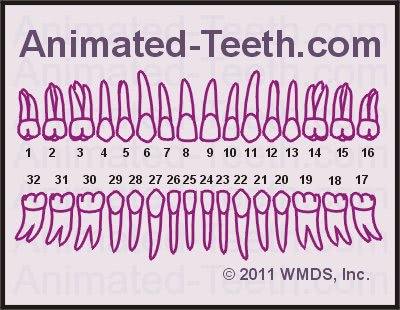
The Universal Numbering System.
- Tooth #1 is the maxillary (upper) right third molar.
- From tooth #1, sequential numbering moves forward along the maxillary arch all the way across and around to the maxillary (upper) left third molar, which is tooth #16.
- Tooth numbering then continues on by dropping down to the mandibular (lower) left third molar (tooth #17).
- It then proceeds all of the way around the mandibular arch until tooth #32, the mandibular (lower) third molar, has been reached.
How the Universal Numbering System works if some teeth are missing.
There is the possibility that a person will have some missing teeth. (Teeth that have been extracted, have not yet come in or else did not form.) In the case of missing teeth, the numbering is carried out as if these teeth did exist. For example:
- If a person has all of their teeth except for their wisdom teeth, their teeth will be numbered 2 through 15 and 18 through 31.
- If a person has had their lower right first molar extracted (tooth #30), the teeth on either side of this tooth space will still keep the numbers 29 and 31.
- Some people have all four of their second premolars (bicuspids) removed as part of their orthodontic treatment plan. Even though once they get their braces off no spaces will exist, when numbering their teeth, the person will still not have teeth assigned the numbers 4, 13, 20, and 29.
Ready to take the quizzes? Use these links!
Permanent Teeth Numbering quizzes – (Tooth chart graphic shown during the quiz.)
Quiz #1 (10 teeth) » Quiz #2 (10 teeth) » Quiz #3 (10 teeth) » Quiz #4 (All 32 teeth)
Permanent Teeth Numbering quizzes – (Text-only format.)
Quiz #1 (10 teeth) » Quiz #2 (10 teeth) » Quiz #3 (10 teeth) » Quiz #4 (All 32 teeth)
Permanent teeth and their assigned numbers. (Universal Tooth Numbering System)

The Universal tooth numbering system for permanent teeth.
Tooth #1: Maxillary (upper) right 3rd molar
Tooth #2: Maxillary (upper) right 2nd molar
Tooth #3: Maxillary (upper) right 1st molar
Tooth #4: Maxillary (upper) right 2nd premolar (bicuspid)
Tooth #5: Maxillary (upper) right 1st premolar (bicuspid)
Tooth #6: Maxillary (upper) right canine (cuspid)
Tooth #7: Maxillary (upper) right lateral incisor
Tooth #8: Maxillary (upper) right central incisor
Tooth #9: Maxillary (upper) left central incisor
Tooth #10: Maxillary (upper) left lateral incisor
Tooth #11: Maxillary (upper) left canine (cuspid)
Tooth #12: Maxillary (upper) left 1st premolar (bicuspid)
Tooth #13: Maxillary (upper) left 2nd premolar (bicuspid)
Tooth #14: Maxillary (upper) left 1st molar
Tooth #15: Maxillary (upper) left 2nd molar
Tooth #16: Maxillary (upper) left 3rd molar
Tooth #17: Mandibular (lower) left 3rd molar
Need a printable teeth numbers chart for permanent (adult) teeth?
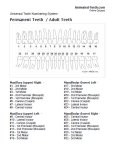
Download our PDF –
Permanent teeth tooth numbers chart.
Tooth #18: Mandibular (lower) left 2nd molar
Tooth #19: Mandibular (lower) left 1st molar
Tooth #20: Mandibular (lower) left 2nd premolar (bicuspid)
Tooth #21: Mandibular (lower) left 1st premolar (bicuspid)
Tooth #22: Mandibular (lower) left canine (cuspid)
Tooth #23: Mandibular (lower) left lateral incisor
Tooth #24: Mandibular (lower) left central incisor
Tooth #25: Mandibular (lower) right central incisor
Tooth #26: Mandibular (lower) right lateral incisor
Tooth #27: Mandibular (lower) right canine (cuspid)
Tooth #28: Mandibular (lower) right 1st premolar (bicuspid)
Tooth #29: Mandibular (lower) right 2nd premolar (bicuspid)
Tooth #30: Mandibular (lower) right 1st molar
Tooth #31: Mandibular (lower) right 2nd molar
Tooth #32: Mandibular (lower) right 3rd molar
b) How does the Universal system work when labeling deciduous teeth?
For baby teeth, the Universal system assigns a letter of the alphabet, ranging from A to T, to each individual tooth.
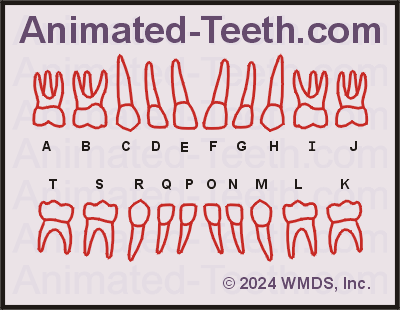
The Universal System for deciduous (baby) teeth.
Here are the rules:
- Tooth letter A is the maxillary (upper) right second molar.
- From tooth A, sequential lettering moves forward along the maxillary arch all the way across and around to the maxillary (upper) left second molar, which is tooth letter J.
- Tooth numbering then continues on by dropping down to the mandibular (lower) left second molar (tooth letter K).
- It then proceeds all of the way around the mandibular arch until tooth letter T, the mandibular (lower) second molar, has been reached.
How the Universal System works if some baby teeth are missing.
There is the possibility that a child will have some missing teeth. (Teeth that have been extracted, have not yet come in, or else did not form.) In the case of missing teeth, the lettering is carried out as if these teeth did exist.
Ready to take the quizzes? Use these links!
Deciduous Teeth Lettering quizzes – (Tooth chart graphic shown during the quiz.)
Quiz #1 (10 teeth) » Quiz #2 (10 teeth) » Quiz #3 (All 20 teeth)
Deciduous Teeth Lettering quizzes – (Text-only format.)
Quiz #1 (10 teeth) » Quiz #2 (10 teeth) » Quiz #3 (All 20 teeth)
Deciduous teeth and their assigned letters. (Universal System)

The Universal System for deciduous (baby) teeth.
Tooth A: Maxillary (upper) right 2nd molar
Tooth B: Maxillary (upper) right 1st molar
Tooth C: Maxillary (upper) right canine (cuspid)
Tooth D: Maxillary (upper) right lateral incisor
Tooth E: Maxillary (upper) right central incisor
Tooth F: Maxillary (upper) left central incisor
Tooth G: Maxillary (upper) left lateral incisor
Tooth H: Maxillary (upper) left canine (cuspid)
Tooth I: Maxillary (upper) left 1st molar
Tooth J: Maxillary (upper) left 2nd molar
Need a printable tooth lettering chart for deciduous (baby) teeth?
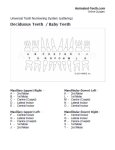
Download our PDF –
Deciduous teeth tooth letters chart.
Tooth K: Mandibular (lower) left 2nd molar
Tooth L: Mandibular (lower) left 1st molar
Tooth M: Mandibular (lower) left canine (cuspid)
Tooth N: Mandibular (lower) left lateral incisor
Tooth O: Mandibular (lower) left central incisor
Tooth P: Mandibular (lower) right central incisor
Tooth Q: Mandibular (lower) right lateral incisor
Tooth R: Mandibular (lower) right canine (cuspid)
Tooth S: Mandibular (lower) right 1st molar
Tooth T: Mandibular (lower) right 2nd molar
Tooth Identification Quizzes
a) The ‘Kinds of Teeth’ quiz.
This is a tooth identification quiz that covers permanent (adult) teeth.
Ready to take the quiz? Use this link! » The Kinds of Teeth quiz.
Exam terms and definitions.
A maxillary (upper) central incisor.
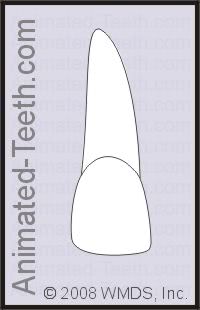
A mandibular (lower) central incisor.
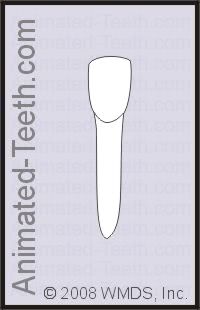
- Incisors –
- Incisors have a broad, chisel-like biting edge and a single root. Upper incisors are larger than lower incisors.
A mandibular (lower) canine (cuspid).
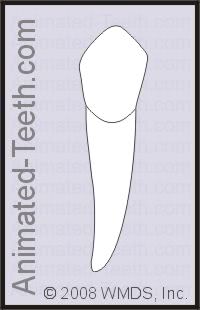
- Canines –
- Canine teeth are also called cuspid or eyeteeth. They have one large pointed cusp and a very long single root.
A maxillary (upper) premolar (bicuspid).
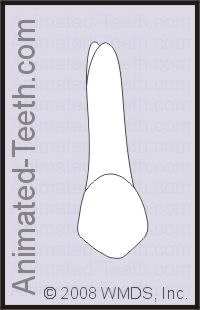
- Bicuspids –
- These teeth (especially the upper ones) usually have two obvious cusps. Lower bicuspids just have one root. Upper ones can have one or two. Bicuspid teeth are also called premolars.
A maxillary (upper) molar.
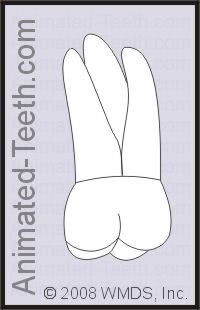
A mandibular (lower) molar.
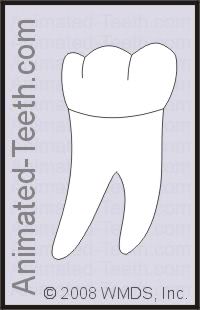
- Molars –
- The molars are the largest teeth in the mouth. They have four or five cusps on their chewing surface. Upper molars have three roots, lower ones just two.
b) The ‘Tooth Type’ and ‘Tooth Name’ quizzes.
These are tooth identification quizzes that cover permanent (adult) teeth.
Ready to take the quizzes? Use these links! » 1)
The Name That Tooth quiz. 2) The Tooth Types quiz.
Exam terms and definitions.
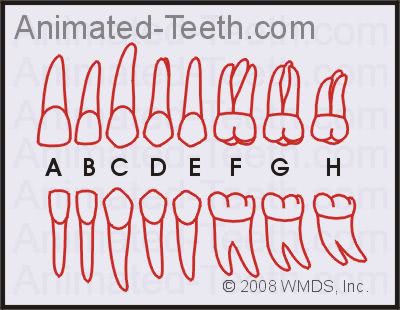
Tooth chart for ‘Name That Tooth’ quiz.
- » Incisors
- these teeth are the first permanent teeth to erupt that replace a deciduous tooth. They have straight biting edges, a flat front surface, and a single root. The shape of these teeth is useful for cutting through food.
- A) Central Incisors –
- these teeth butt up against the midline of the mouth, making them the center-most teeth. Upper central incisors are larger than upper lateral incisors. Lower central incisors are the smallest teeth in the mouth.
- B) Lateral Incisors –
- the second teeth from the midline. Upper lateral incisors look like upper central incisors but are smaller in size. Lower lateral incisors are slightly larger than lower central incisors.
- C) Canines –
- the third tooth from the midline. These teeth are also known as eyeteeth and cuspids. Their biting edge is composed of a single large cusp that is suited for both seizing and holding food as well as cutting and tearing it. Canines have a single root. These teeth are the longest in their respective jaws, the upper canine being the longest tooth in the mouth.
- » Premolars
- these teeth are also known as bicuspids. They have a shape that is useful for both cutting and tearing as well as crushing food.
- D) First Premolars –
- the fourth tooth from the midline in each quadrant. Upper first premolars have two distinct cusps and have either one or two roots. Lower first premolars are the smallest type of premolar. They have one root, a prominent cheek-side cusp, and a less pronounced tongue-side cusp.
- E) Second Premolars –
- the fifth tooth from the midline. Second premolars have one root. Upper second premolars have two distinct cusps. Lower second premolars have a single cheek-side cusp and either one or two less pronounced tongue-side cusps.
- » Molars
- these teeth have broad surfaces that are used to crush and grind food. They have four or five distinct cusps, however, the cusps are shorter and more blunted than those found on other cusped teeth.
- F) First Molars –
- the sixth tooth from the midline in each quadrant. Another term for these teeth is “six-year molars” since they usually come in at age six years. These teeth are the first permanent ones to come in that do not replace a deciduous tooth. Upper first molars have four (or possibly five) prominent cusps and three roots. Lower first molars have five cusps and only two roots.
- G) Second Molars –
- the seventh tooth from the midline. Another term for these teeth is “twelve-year molars” since they usually come in at age twelve years. Upper second molars have four cusps and three roots. Lower second molars have four cusps and two roots. Second molars are usually slightly smaller in size than first molars.
- H) Third Molars –
- the eighth tooth from the midline. Another term for these teeth is “wisdom teeth.” Upper third molars have four cusps and three roots. Lower third molars have four cusps and two roots. The roots of third molars are often fused together, at least somewhat. Third molars are usually smaller in size than second molars.
c) The ‘Which Type of Tooth is This?’ quiz.
This is a tooth identification quiz that covers permanent (adult) teeth.
Ready to take the quiz? Use this link! » The Which Type of Tooth is This quiz.
Exam terms and definitions.
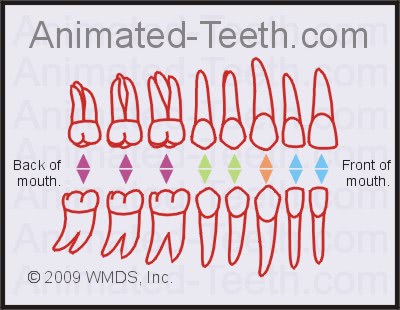
Tooth chart for ‘Type of Tooth’ quiz.
- Incisors –
- Incisors are the teeth found in the center of the mouth. They have a broad chisel-like edge and a single root. We use them to bite our food into pieces. (Blue arrows)
- Canines –
- Canine teeth are also called cuspid or eyeteeth. They have one pointed cusp and a long single root. They are used to tear food. Cats and dogs have very big canine teeth. (Orange arrows)
- Bicuspids –
- Bicuspids are located between the molar and canine teeth. They usually have two pointed cusps and can have one or two roots. We use them to tear and crush food. (Green arrows)
- Molars –
- Molars are the teeth that are positioned furthest back in the mouth. Their function is to crush and grind food. Lower molars have two roots, upper ones have three. (Purple arrows)
- Anterior teeth [front teeth] –
- Anterior teeth are those teeth that are located closest to the front of the mouth. The anterior teeth are the incisors and the canines. (Blue and orange arrows)
- Posterior teeth [back teeth] –
- Posterior teeth are those teeth that are located in the rear of the mouth. The posterior teeth are the bicuspids and the molars. (Green and purple arrows)
d) The ‘Which type of baby tooth is this?’ quiz.
These are tooth identification quizzes that cover deciduous (baby) teeth.
Ready to take the quizzes? Use these links! » 1)
The Which Type of Baby Tooth is This?’ quiz. 2) Deciduous Teeth quiz.
Exam terms and definitions.
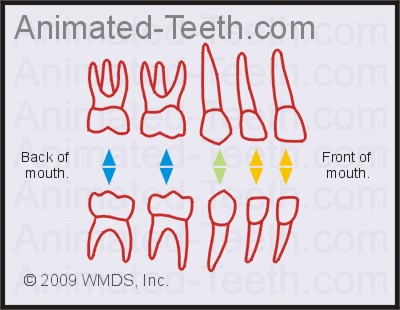
Tooth chart for ‘Baby Teeth’ quiz.
- Incisors –
- Incisor teeth are found in the very front of the mouth. We use our incisor teeth to bite food into pieces. There are eight deciduous incisor teeth. (Gold arrows)
- Canines –
- Canine teeth are also called eyeteeth or cuspids. These pointed teeth are used to tear food. Dogs and cats have very big canine teeth. There are four deciduous canine teeth. (Green arrows)
- Molars –
- The molars are found in the rear of the mouth. We use them to crush and grind food. There are eight deciduous molars. (Blue arrows)
- Anterior teeth [front teeth] –
- Anterior teeth are those teeth that are located in the front portion of the mouth. The anterior deciduous teeth are the incisors and the canines. (Gold and green arrows)
- Posterior teeth [back teeth] –
- Posterior teeth are those teeth that are found in the back of the mouth. The posterior deciduous teeth are the molars. (Blue arrows)